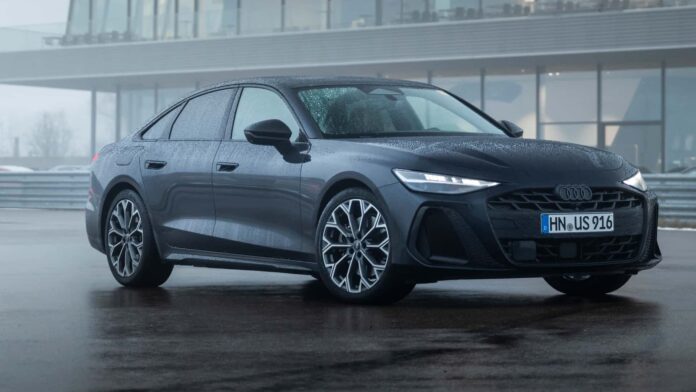With the European Union breathing down automakers’ necks to slash emissions, the diesel engine is gradually fading. Its market share has plunged from over 50 percent in the pre-Dieselgate era to just eight percent in the first ten months of the year. That puts diesel in fourth place among drivetrains, far behind hybrids, gasoline, and even plug-in hybrids. Yes, for the first time ever, PHEVs are outselling diesels on the continent.
But Audi isn’t ready to retire the TDI just yet. The company has been selling diesel-powered cars since 1989 and even won Le Mans eight times with a TDI endurance racer. It once shoehorned a massive V-12 diesel into the R8 supercar, though it never reached production. Fast-forward to 2025, and there’s a new 3.0-liter V-6 with an electric twist.
Debuting in the A6 and Q5, Audi’s new six-cylinder diesel pairs a mild-hybrid system with an electrically powered compressor. Although Ingolstadt has offered 48-volt diesels before, this is the first time the MHEV hardware works in tandem with an electrically driven compressor. The unit is mounted behind the turbocharger and intercooler in the intake path.
When you floor the accelerator, and the turbocharger has little energy to work with, the intake air is routed to the electrically powered compressor. Already compressed by the exhaust-driven turbo, the air is squeezed even further before entering the combustion chamber. The result is more torque at low rpm and virtually no turbo lag. Audi even claims the latest V-6 diesel offers response comparable to a similarly powered electric car.
Photo by: Audi
As for output, the 3.0-liter unit delivers 295 hp at 3,620 rpm and 428 lb-ft (580 Nm) from 1,500 rpm. Compared to its predecessor, the maximum boost pressure of 3.6 bar builds nearly a full second quicker. The compressor wheel also spins about 40 percent faster, hitting 90,000 rpm in just 250 milliseconds. That translates to sharper response off the line, with the vehicle covering “a good car length more” in the first two and a half seconds.
When pulling away, the mild-hybrid system adds a temporary 24 hp and 170 lb-ft (230 Nm). Impressive figures, but how do they translate on the road? An A6 Sedan equipped with the V-6 diesel sprints to 62 mph (100 km/h) in 5.2 seconds and tops out at 155 mph (250 km/h). The slightly heavier wagon needs just a tenth more.
Despite matching the A6 Sedan’s weight, the Q5 is actually quicker. Regardless of whether you choose the conventionally shaped SUV or the sleeker Sportback, both hit 62 mph in five seconds flat and share the same governed top speed as the A6. As impressive as all of this sounds, the diagram illustrating the drivetrain’s complexity would have us worried that something could go awry.

15
Source: Audi
But Audi claims we shouldn’t worry because durability has been improved compared to the previous V-6 diesel. Additionally, fuel efficiency is up. But to be clear, this isn’t an all-new engine. The “EA897evo4” codename confirms it’s the latest evolution of a Volkswagen Group diesel first introduced in 2010. It even powered certain Porsche models before Zuffenhausen abandoned diesel entirely after the Dieselgate scandal. Indeed, the EA897 was part of the debacle surrounding emissions-cheating devices.
Still, Audi insists this latest V-6 is its cleanest yet. It can even run on hydrotreated vegetable oil (HVO), which reduces CO₂ emissions by up to 95 percent compared to conventional diesel. Made from used cooking oil and agricultural by-products, HVO is already being filled into diesel cars built at Audi’s Neckarsulm and Ingolstadt plants in Germany.
We would typically expect to see this engine in the A7, but the large Sportback is unlikely to get a next generation. The future of the A8 flagship is also up in the air. Next year’s Q7 and even larger Q9 are likely going to receive the updated V-6 diesel.
